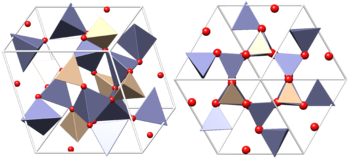Willemite
| Willemite | |
|---|---|
 Willemite with franklinite from New Jersey | |
| General | |
| Category | Silicate mineral |
| Formula (repeating unit) | Zn2SiO4 |
| Strunz classification | 9.AA.05 (10 ed) 8/A.01-20 (8 ed) |
| Dana classification | 51.1.1.2 |
| Crystal system | Trigonal |
| Crystal class | Rhombohedral (3) H-M symbol: (3) |
| Space group | R3 |
| Identification | |
| Color | Colorless to white, gray, flesh-red, dark brown, honey-yellow, apple-green, blue |
| Crystal habit | Fibrous, botryoidal to massive |
| Cleavage | {0001}, {1120} - imperfect |
| Fracture | Irregular to conchoidal |
| Mohs scale hardness | 5.5 |
| Luster | Vitreous to resinous |
| Diaphaneity | Transparent to opaque |
| Specific gravity | 3.9 - 4.2 |
| Optical properties | Uniaxial (+) |
| Refractive index | nω = 1.691 - 1.694 nε = 1.719 - 1.725 |
| Birefringence | δ = 0.028 |
| Other characteristics | Strongly fluorescent - may be phosphorescent |
| References | [1][2][3] |
Willemite is a zinc silicate mineral (Zn2SiO4) and a minor ore of zinc. It is highly fluorescent (green) under shortwave ultraviolet light. It occurs in all different colors in daylight, in fibrous masses, solid brown masses ("troostite"), and apple green gemmy masses.
It was discovered in 1830 and named after William I of the Netherlands.[3]
Formation and associated minerals
Willemite is usually formed as an alteration of previously existing sphalerite ore bodies, and is usually associated with limestone. It is also found in marble and may be the result of a metamorphism of earlier hemimorphite or smithsonite.[4] It occurs in many places, but is best known from Arizona and the zinc, iron, manganese deposits at Franklin and Sterling Hill Mines in New Jersey. It often occurs with red zincite (zinc oxide) and franklinite (Fe,Mn,Zn)(Fe,Mn)2O4 (an iron rich zinc mineral occurring in sharp black isometric octahedral crystals and masses). Franklinite and zincite are not fluorescent.
Uses
Artificial willemite was used as the basis of first-generation fluorescent tube phosphors. Doped with manganese-II, it fluoresces with a broad white emission band. Some versions had some of the zinc replaced with beryllium. In the 1940s it was largely replaced by the second-generation halophosphors based on the fluorapatite structure. These, in turn have been replaced by the third-generation TriPhosphors.[5][6]


Photo comparison

See also
References
- ^ http://rruff.geo.arizona.edu/doclib/hom/willemite.pdf Handbook of Mineralogy
- ^ http://www.mindat.org/min-4292.html Mindat
- ^ a b http://webmineral.com/data/Willemite.shtml Webmineral
- ^ Klein, Cornelis (2007). The Manual of Mineral Science, p.484. John Wiley and Sons, Inc., Hoboken. ISBN 9780471721574.
- ^ Thayer, R. N. "The Fluorescent Lamp: Early U. S. Development".
- ^ Kane, Raymond; Sell, Heinz (2001). "A Review of Early Inorganic Phosphors". Revolution in lamps: a chronicle of 50 years of progress. p. 98. ISBN 978-0-88173-378-5.
External links
 Media related to Willemite at Wikimedia Commons
Media related to Willemite at Wikimedia Commons
